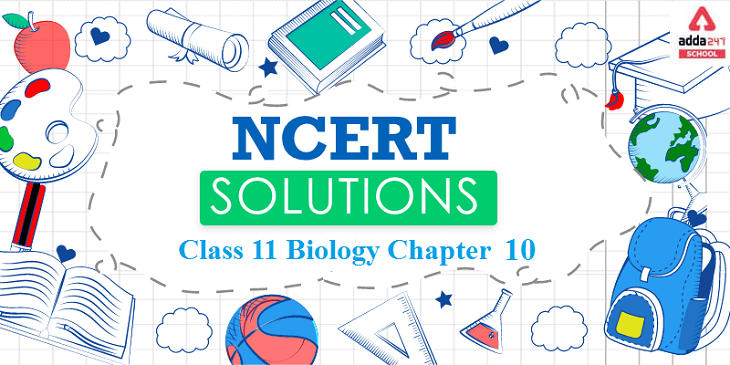Table of Contents
Class 11 Biology Chapter 10 NCERT Solutions in English
Adda 247 provides Class 11 Biology Chapter 10 NCERT Solutions which is for the students who want to go ahead in life and achieve great marks in their examinations. The NCERT Solutions for class 11 are provided by the teachers who are experts of their subjects. The solutions are set according to the rules formulated by the NCERT class 11 biology and in the language that can be understood by every student. By reading the solutions students can build up a strong base easily. The NCERT class 11 Biology solutions cover chapters 1 to 22 with the important questions and the answers in a detailed way.
Examinations can be threatening for some people, a proper learning of the concepts is the key to crack the examination. Students rely on the solutions of the NCERT provided by Adda 247. The solutions are formulated by the experts of the subjects who have tremendous knowledge in their subjects.
These NCERT Solutions of class 11 help the students to get familiarized with the textbooks. The students can access the solutions anywhere while browsing the web easily. The solutions are very precise and accurate.
NCERT Solutions for Class 11 Biology Chapter 10 – Cell Cycle and Cell Division
The chapter provides information about Cell cycle and cell division. The cell cycle is an ordered series of events involving cell growth and cell division that produces two new daughter cells. Cells on the path to cell division proceed through a series of precisely timed and carefully regulated stages of growth, DNA replication, and division that produce two genetically identical cells. The cell cycle has two major phases: interphase and the mitotic phase. During interphase, the cell grows and DNA is replicated. During the mitotic phase, the replicated DNA and cytoplasmic contents are separated and the cell divides.
Features of the NCERT Solutions Class 11 Biology Chapter 10
NCERT Solutions Class 11 biology chapter 10 has been answered based on the important information on the question.
- The columns are used wherever necessary.
- Solutions are solved point-wise and accurately answered point to point.
Important Questions NCERT Solutions for Class 11 Biology Chapter 10
Question 1. What is the average cell cycle span for a mammalian cell?
Answer: The average cell cycle span for a mammalian cells is 24 hours.
Question 2. Distinguish cytokinesis from karyokinesis.
| Cytokinesis | Karyokinesis |
| Cytokinesis is the biological process that involves the division of a cytoplasm of the cell during mitosis or meiosis. | It is the biological process that involves the division of nucleus of the cell during mitosis or meiosis. |
| Stages are not present. | It involves four stages – prophase, metaphase , anaphase and telophase. |
Question 3. Describe the events taking place during interphase.
Answer: Interphase is the resting phase of the cell cycle which covers 95% of the total duration of a cell cycle. It involves a series of changes which prepare cell for division. It is the period in which the cell experiences growth and DNA replication in an orderly manner. It is divided into three phases:
(i) G1 phase: It is the interval between mitosis and initiation of DNA replication. It is the period where the cell grows and prepares its DNA for replication. The cell is metabolically active but no replication occurs.
(ii) S phase: This is the synthesis phase during which DNA replication occurs. The amount of DNA doubles but chromosome number remains same.
(iii) G2 phase: The cell continues to grow and prepare itself for division. The proteins and RNA re required for mitosis.
Question 4. What is Go (quiescent phase) of cell cycle?
Answer: G0 (quiescent phase) also known as the inactive stage of the cell cycle, is the stage when the cell remains metabolically active, but do not proliferate unless called on to do so. Such cells are used for replacing the cells lost during injury.
Question 5. Why is mitosis called equational division?
Answer: Mitosis is known as equational division because the daughter cells produced in this process have the same number of chromosomes as that in the parent cell.
Question6. Name the stage of cell cycle at which one of the following events occur:
(i) Chromosomes are moved to spindle equator.
(ii) Centromere splits and chromatids separate.
(iii) Pairing between homologous chromosomes takes place.
(iv) Crossing over between homologous chromosomes takes place.
Answer:
(i) Metaphase of mitosis
(ii) Anaphase of mitosis
(iii) Zygotene stage of meiosis I (iv) Pachytene stage of meiosis I
Question 7. Describe the following:
(a) synapsis (b) bivalent (c) chiasmata Draw a diagram to illustrate your answer.
Answer:
(i) The pairing of homologous chromosomes is called synapsis. This occurs during the second stage of prophase I or zygotene.
(ii) Bivalent or tetrad is a pair of synapsed homologous chromosomes. They are formed during the zygotene stage of prophase I of meiosis.
(iii) Chiasmata is the site where two non-sister chromatids of homologous chromosomes have crossed over. It represents the site of cross-over. It is formed during the diplotene stage of prophase I of meiosis.
Question 8. How does cytokinesis in plant cells differ from that in animal cells?
| Plant cytokinesis | Animal cytokinesis |
| Cell plate formation takes place. | Cleavage takes place. |
| Cell wall formation starts in the middle and grows outwards. | The furrow begins from the plasma membrane and joins in the centre. |
| During cell plate formation, vesicle fusion takes place. | The contraction of peripheral ring of microfilaments initiates cleavage. |
Question 9. Find examples where the four daughter cells from meiosis are equal in size and where they are found unequal in size.
Answer:
(a) Spermatogenesis is the formation of sperms in human beings which takes place by meiosis and results in formation of four equal sized daughter cells.
(b) Oogenesis is the formation of ovum in human beings takes place by the process of meiosis. It results in the formation of four daughter cells which are unequal in size.
Question 10. Distinguish anaphase of mitosis from anaphase I of meiosis. Answer:
Anaphase of mitosis :
- Anaphase stage is characterised by the following key events:
(i) Centromeres split and chromatids separate. (ii)Chromatids move to opposite poles.
- Each chromosome arranged at the metaphase plate gets split simultaneously and the two daughter
chromatids, now referred to as chromosomes of the future daughter nuclei, begin their migration
towards the two opposite poles.
- As each chromosome moves away from the equatorial plate, the centromere of each chromosome is
towards the pole and hence at the leading edge, with the arms of the chromosome trailing behind.
Anaphase I of meiosis :
1.The homologous chromosomes separate, while sister chromatids remain associated at their
centromeres
2.The spindle fibres contract and pull the centromeres of homologous chromosome towards the
opposite poles.
3.The centromere is not divided. Thus half of the chromosomes of the parent nucleus go to one pole and the remaining half in the opposite pole.


 NEET Chemistry Syllabus 2025, Check Clas...
NEET Chemistry Syllabus 2025, Check Clas...
 NEET UG 2025 News: Check NEET Exam Mode
NEET UG 2025 News: Check NEET Exam Mode
 CBSE Board Exams 2025 Latest News- Recen...
CBSE Board Exams 2025 Latest News- Recen...





























